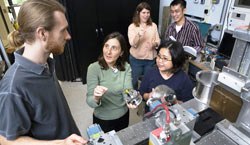X-RAY RUNS: Apply for Beamtime
2017 Nov 1 - Dec 21
2018 Feb 7 - Apr 3
2018 Proposal/BTR deadline: 12/1/17
2018 Apr 11 - Jun 4
2018 Proposal/BTR deadline: 2/1/18

Of Waltzing Proteins and Whispering RNA
By Sourish Basu (Cornell graduate student)
Lois Pollack loves to build tools. One of her favorites is a paper-thin purple square of silicon, less than an inch across, with channels thinner than a human hair. "This is one of the earlier mixers I built," says the associate professor of applied and engineering physics. Looking at it, it’s hard to believe that this "mixer"—two microscopic channels etched cross-ways—in the late 1990s became a new window on how proteins danced their tangled dance during the first few moments of folding.
Proteins, which account for about a fifth of our weight, are polymeric chains of up to 20 different amino acids. Each protein is hundreds to tens of thousands of amino acids long and performs a very specific function in our body; hemoglobin in our blood carries oxygen, and myosin in our muscles gets us moving. To perform such specific functions, proteins have to fold up in specific three-dimensional structures and sometimes toggle between different ones. A protein called VIVID, for example, found in a bread mold, changes its conformation when exposed to light to keep the fungus’ Circadian rhythms in sync with the sun.
Read the full article in the Spring 2009 issue of the Cornell College of Engineering Magazine archived PDF here.
11/2009
submitted by: E. Fontes
